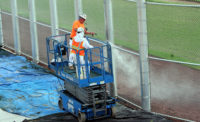...have other jobs and responsibilities,” says Brad Gabel, vice president of Kitchell’s Native American division. “They need flexibility from their business partners. That might mean meeting them on a weekend, in an area far from an urban area.”
More schedule difficulty can arise due to customs or holidays particular to the tribe.
“We’ve worked in communities where, if there’s a funeral, we don’t work that day,” Flintco’s Woods says. “We’ve worked in areas where it’s ceremonial time and it’s not a time for work to happen.”
Tribal contacts are often groups, not individuals, and decisions are made by consensus. The process can involve several members with other demands on their time, multiple committees, the tribal council and in many cases tribal elders. Designers and contractors are often excluded from discussions, something that can be misunderstood by those used to the open public meeting process.
On the other hand, industry jargon and practices second nature to construction pros can be baffling to clients, Giff says.
“Sometimes that causes misunderstanding,” he says. “They have the same priorities, the same intentions, the same goals; it’s just a matter of better communication.”
Sitting down together early and often is a good way to avoid communication pitfalls and integrate all-important cultural ideals, says Richard Begay, an architect-in-training with Phoenix-based DLR group who has worked on several K-12 and other tribal projects in the region.
“What is that layer that makes a Native American project so special and unique?” asks Begay, a member of the Navajo Nation. “It goes back to values, cultural context, the relationship to land, the elements, cultural landmarks, rivers and mountains.”
The payoff for research and attention to cultural nuance goes beyond the typical. Project success is measured as much in tribal self-sufficiency, community pride and other far-reaching benefits as immediate ones, Giff said.
“These projects can present their own unique challenges, but there is an added sense of accomplishment when you are able to see how it improves the lives of the local community members,” Arviso/Okland’s Johnson says. “It is a great experience attending school ribbon-cutting ceremonies and being a part of not only the cultural ceremonies, but also seeing the look on the children’s faces as they see their beautiful new schools.”
Architect Stroh agrees. “I just really enjoy it,” he says. “It’s fun getting to do more architecture than red tape.”
Useful Sources:
Construction in Indian Country, part of the Del E. Webb School of Construction at Arizona State University, will hold its 7th annual conference in May. See our Calendar of Events for more info or visit construction.asu.edu/ciic.








Post a comment to this article
Report Abusive Comment